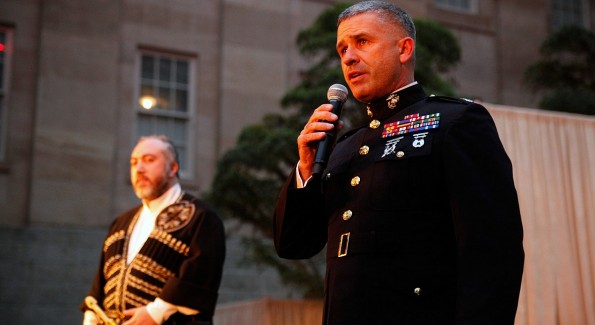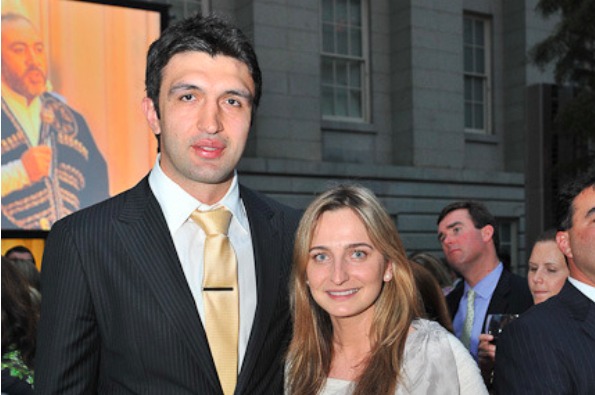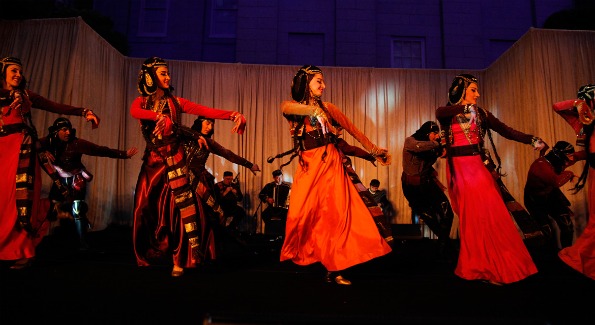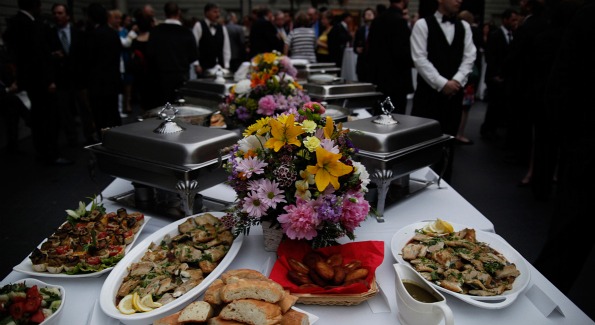Georgia celebrates the 20th anniversary of the restoration of its independence at the National Portrait Gallery, with music, food, art and wine indigenous to its rich culture.
By John Arundel
The sovereign state of Georgia bordering Russia, Turkey, Armenia and Azerbaijan is better known for its recent history of invasions and occupation. As remarkably beautiful as Georgia is, it is said that the Eurasian country has always been a victim of its geography. But Georgia’s 4.7 million people have never stopped pursuing their own, independent future and a yearning for a normal life. Georgians never stopped living the “Georgian way of life.”
Those cultural hallmarks were celebrated in grand style Tuesday at the National Portrait Gallery‘s Donald W. Reynolds Center for the Arts, where nearly 1,000 people turned out to celebrate the 20th anniversary of the restoration of Georgia’s independence. The larger-than-grand event was visually stunning, causing more than even a few jaded Washingtonians to gasp at the event’s scope and breadth.
As guests checked in, two calligraphist and Batik artists were on hand to write down their names on silk Georgian Batik pieces. The celebration continued with a concert by the Georgian musical group The Shin, which wove together their distinctively Georgian sound with the musical threads of India, the Iberian peninsula, American jazz and European classical music.
The performance was followed by the soaring remarks of Ambassador Temuri Yakobashvili, who gave an uplifting yet traditional Georgian toast. “Georgia cannot be discovered through words and paper,” Yakobashvili said. “It needs to be felt. One needs to drink its wine and toast to its past and future.
“In the small streets of Tbilisi, on the squares of Batumi or under the balconies of ancient townhouses, a visitor will discover how Georgia has already been a part of your life — even if you didn’t know it,” he toasted.
According to a Georgian legend, he said, on the day God was allocating parts of the world to the people of the Earth, the Georgians were feasting. As a result, they arrived late and were told by God that all of the land had already been distributed. When the Georgians replied that they were late only because they had been lifting their glasses in praise of Him, God was said to be pleased. In return, He gave the Georgians that part of Earth that He had been reserving for Himself. This is a phenomenon known by Georgians as the “Georgian syndrome.”
“When one immerses himself in this small country on the coast of the Black Sea and surrounded by Caucasian mountains, one falls in love with it, and can never get Georgia out of their mind,” Yakobashvili added.
The Georgian envoy then played the part of the “tamada” (toastmaster), inviting his guests to partake in the traditional Supra dinner, giving several toasts with Georgian wine.
Four chefs came from Georgia to cook for the event, and the Georgian wine flowed freely. The wines served included some real gems like the Bagrationi Classic Brut from Bagrationi (1982), Tsinandali from Teliani Valley (2008) and Saperavi from Eniseli Wines (2007).
Georgia is the oldest wine-producing region in the world, its Embassy’s Cultural Attache Zoe Reyners said, adding that a moderate climate and moist air influenced by the Black Sea create ideal conditions for vine cultivation. “The tradition of viniculture in Georgia is entwined and inseparable from the country’s national identity,” Reyners said.
Opera singer Sophie Nizharadze performed the Georgian and United States national anthems. Nizharadze was born in Tbilisi and studied piano and vocals at the Tbilisi State Conservatory. “She is among Georgia’s most promising musical talents and at age 24 has already performed with musical legends Jose Carreras and Andrea Bocelli,” Reyners said.
The Georgian National Ballet Sukhishvili also performed, with Batumi singing and dancing fountains. Batumi is a seaside city on the Black Sea coast and the capital of Adjara, an autonomous republic in southwest Georgia, located near the border with Turkey.
In recent years Batumi has become the new touristic hub of the region, with its subtropical climate, five star hotels, and proximity to top ski resorts in the Caucasian mountains.
Batumi’s attractions include its many fountains, which appear to “dance” to its lush surroundings.
Iliko Sukhishvili and Nino Ramishvili founded the Georgian National Ballet in 1945, determined to reflect the emotionally daring spirit of Georgia, its invincible vitality and touching romanticism through traditional Georgian dancing.
Three generations of the Sukhishvili family, now represented by Nino and Iliko Sukhishvili Jr., have dedicated their lives to the Georgian National Ballet, which counts about 70 dancers. The evening also included a Georgian photography portrait exhibit and special performances and art displays, including a Georgian calligraphy and Batik performance.
Appearing on huge projection screens in the courtyard of the National Portrait Gallery were highlights of a documentary by Irakli Makhardze on Wild West Georgians, which deals with the extraordinary Georgian trick horse riders who, at the close of the 19th century, participated in popular Wild West shows, exerting with their colorful reputation a significant influence on American rodeos.
Also projected on the walls were a juxtaposition of photographs from the 19th Century Ermakov Collection and from the “Georgia New Generation” exhibit of Contemporary Georgian photographers. The photographs document portraits of members of the Georgian aristocracy, sweeping, mountainous landscapes as well as many photographs of Tbilisi and Batumi, whose subtle charms are heightened by their mixture of the Oriental and the European. The historical images were taken by Alexandre Roinashvili (1846-1898), the first Georgian photographer, and by the famous Dimitri Ermakov.
Another selection of photographs introduced attendees to the work of the Georgian masters of modern photography such as Yuri Mechitov, Guram Tsibakhashvili, Beso Uznadze, David Meskhi and Marika Asatiani. The art exhibit also reflected on the Georgian alphabet, the art of painting on silk (Batik) and the Great Silk Road legacy, the network of trade routes connecting China to Europe which traders used for 3,000 years.
“Batik has long been one of the great traditions and cultural legacies resulting from the Silk Road,” Reyners said.
There was also a 3D art exhibit, “My Guilty Pleasure” by Gia Kereselidze, a Georgian born artist and film director.
“For him art is everything and everything is art,” Reyners marveled. “As Gia says, when he creates art he has to be in love, because he believes that without this magical feeling nothing can be done in this world, be it music, film, or any other form of art. Gia thinks that love brings you into a different dimension – that’s why his show was created in 3D.”
GEORGIANS: Lasha Abuseridze, Levan Varshalomidze, Lika Mamatsashvili, Claire Scoville
Nik Apostolides, Gia Kereselidze, Sandro Kereselidze, Kate McMillan, Johanna Mutz, Carole Neves, Amy Sacco, Tim Tomkinson.








